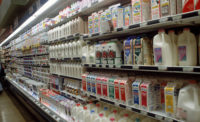Sales of milk shift to club, dollar stores


Doug Adams, president of Prime Consulting Group, presented the results in a webinar for reporters in September.
Retailers account for about 60% of the milk sold in the United States. Prime looked at additional channels of distribution, including restaurants, schools and institutional outlets (such as the military, hospitals and prisons). Prime analyzed customer sales records of 28 dairy processors, representing 4 million sales and 250,000 retail and foodservice outlets.
While sales of white milk fell 2.1% to 5.4 billion gallons in 2011 from 2010 levels, sales of organic white milk increased 17% to 229 million gallons. At club stores, organic milk sales increased 57%. The product accounts for 13.6% of the milk sold in club stores.
The analysis showed that grocery stores lost 115 million gallons of milk sales in 2011, a decline of 4%. Volume at mass merchandisers (including Wal-Mart) declined 2.3% to 892 million gallons. (Sales had been increasing from 2008 to 2010.) Drug store volume, on the other hand, increased 4.8% to 128.7 million gallons.
Citing research from The Food Marketing Institute, Adams said conventional supermarkets are the primary choice of 64% of shoppers. They are doing their shopping at mass merchandisers, club stores and dollar stores. Supercenters, dollar stores, club stores and convenience stores have added 150 million square feet of space since 2005, according to FMI. Grocery stores, on the other hand, have not been adding space.
Foodservice represents 14.2% of milk sales, according to Prime’s research. This category consists of restaurants and non-restaurants, including colleges, healthcare facilities, corrections facilities, and travel and leisure outlets. Limited-service restaurants sold the most milk (291.7 million gallons, a 3.6% increase from 2010 to 2011). Coffee shops (178.6 million gallons) were second and colleges/universities (146 million gallons) were third.
Adams made some recommendations for milk processors to re-capture milk sales in various channels. At large-format grocery stores, processors need to analyze the flavor mix they offer. If consumers can’t find the products they want, they’ll shop elsewhere. At club stores, single-serve and flavored milks are “key opportunities.” Extended shelf-life products might be required.
Looking for a reprint of this article?
From high-res PDFs to custom plaques, order your copy today!








